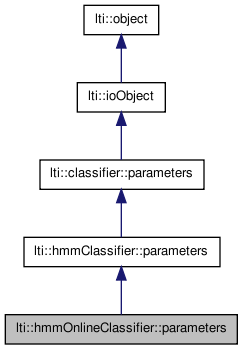

|
latest version v1.9 - last update 10 Apr 2010 |
|
the parameters for the class hmmOnlineClassifier More...
#include <ltiHmmOnlineClassifier.h>


Public Member Functions | |
| parameters () | |
| parameters (const parameters &other) | |
| virtual | ~parameters () |
| const char * | getTypeName () const |
| parameters & | copy (const parameters &other) |
| parameters & | operator= (const parameters &other) |
| virtual classifier::parameters * | clone () const |
| virtual bool | write (ioHandler &handler, const bool complete=true) const |
| virtual bool | read (ioHandler &handler, const bool complete=true) |
Public Attributes | |
| float | pruningThreshold |
| int | maxActiveHypotheses |
| int | numberOfBuckets |
| int | automaticTraceBack |
the parameters for the class hmmOnlineClassifier
| lti::hmmOnlineClassifier::parameters::parameters | ( | ) |
default constructor
Reimplemented from lti::hmmClassifier::parameters.
| lti::hmmOnlineClassifier::parameters::parameters | ( | const parameters & | other | ) |
copy constructor
| other | the parameters object to be copied |
Reimplemented from lti::hmmClassifier::parameters.
| virtual lti::hmmOnlineClassifier::parameters::~parameters | ( | ) | [virtual] |
destructor
Reimplemented from lti::hmmClassifier::parameters.
| virtual classifier::parameters* lti::hmmOnlineClassifier::parameters::clone | ( | ) | const [virtual] |
returns a pointer to a clone of the parameters
Reimplemented from lti::hmmClassifier::parameters.
| parameters& lti::hmmOnlineClassifier::parameters::copy | ( | const parameters & | other | ) |
copy the contents of a parameters object
| other | the parameters object to be copied |
Reimplemented from lti::hmmClassifier::parameters.
| const char* lti::hmmOnlineClassifier::parameters::getTypeName | ( | ) | const [virtual] |
returns name of this type
Reimplemented from lti::hmmClassifier::parameters.
| parameters& lti::hmmOnlineClassifier::parameters::operator= | ( | const parameters & | other | ) |
copy the contents of a parameters object
| other | the parameters object to be copied |
Reimplemented from lti::hmmClassifier::parameters.
| virtual bool lti::hmmOnlineClassifier::parameters::read | ( | ioHandler & | handler, | |
| const bool | complete = true | |||
| ) | [virtual] |
read the parameters from the given ioHandler
| handler | the ioHandler to be used | |
| complete | if true (the default) the enclosing begin/end will be also written, otherwise only the data block will be written. |
Reimplemented from lti::hmmClassifier::parameters.
| virtual bool lti::hmmOnlineClassifier::parameters::write | ( | ioHandler & | handler, | |
| const bool | complete = true | |||
| ) | const [virtual] |
write the parameters in the given ioHandler
| handler | the ioHandler to be used | |
| complete | if true (the default) the enclosing begin/end will be also written, otherwise only the data block will be written. |
Reimplemented from lti::hmmClassifier::parameters.
after the given number of timesteps, a partial trace back is performed and the calculated values are saved internally.
this is done to keep the trace back field small and the scores low. a value of 0 disables automatic trace back. default is 0.
describes the maximum number of active hypotheses (histogram pruning).
if more hypotheses (i.e. paths within a model) are active, the worst hypotheses are thrown away. for value 0, no histogram pruning is performed. this value should be adjusted depending on the number of models. default is 1000.
defines the number of buckets for the bucket-sort-algorithm used in histogram pruning.
when performing histogram pruning, one bucket-sort-run is performed and the hypotheses in the buckets for the lowest scores are kept, so that there are at most maxActiveHypotheses active. the more buckets there are, the closer the number of surviving hypotheses will get to the given maximum count. (the number of buckets has no influence on run time!) default is 100.
additive constant used for pruning (beam search).
all hypotheses that have a score greater than minScore + pruningThreshold are thrown away. For values lower than 0, no beam search is performed. default is 1000, but this is no generally reasonable value. the threshold depends strongly on the number of features and the trained data.